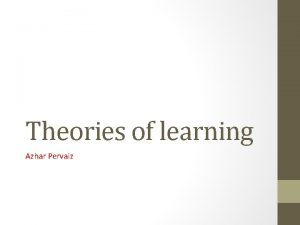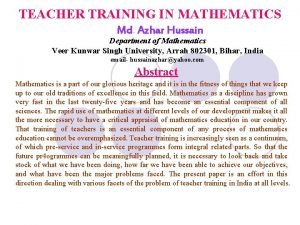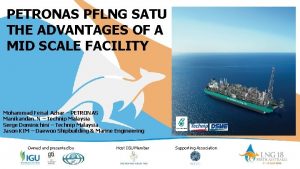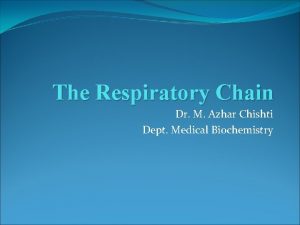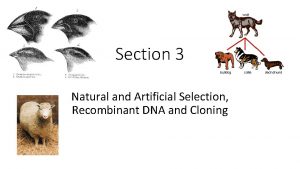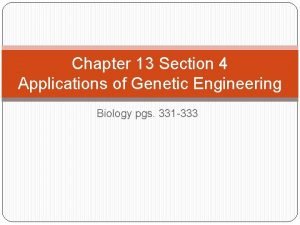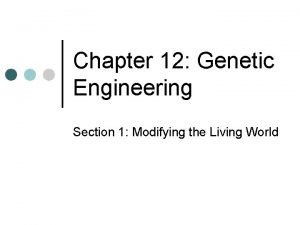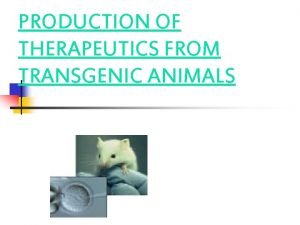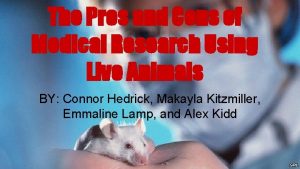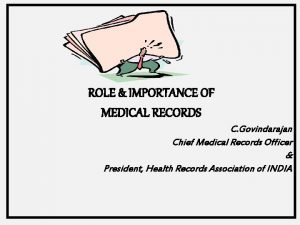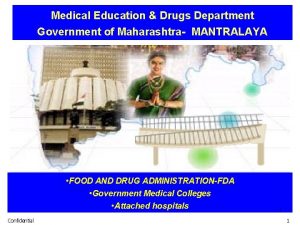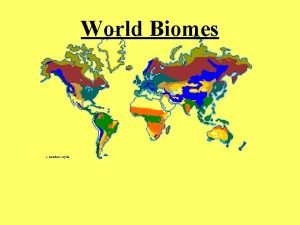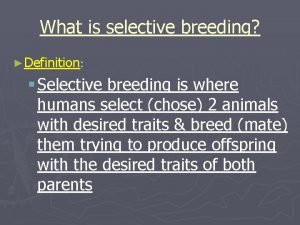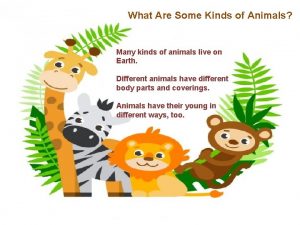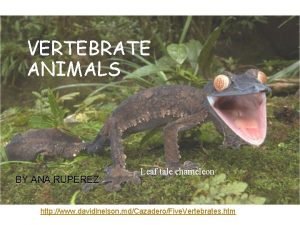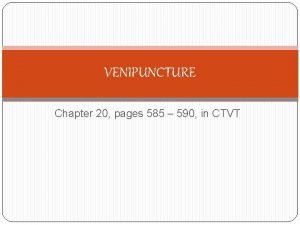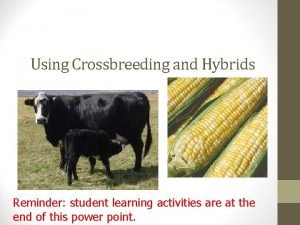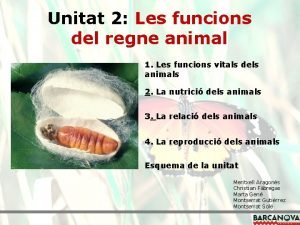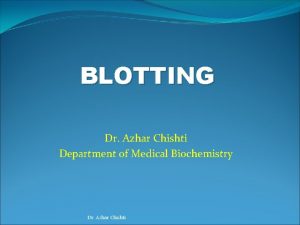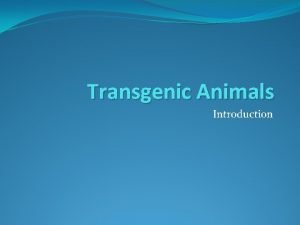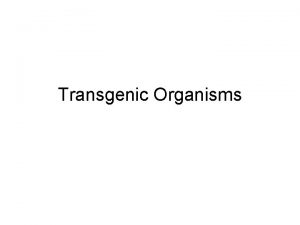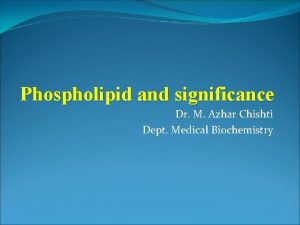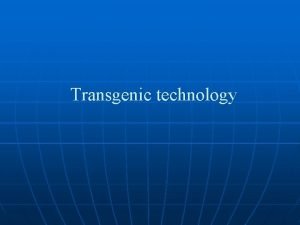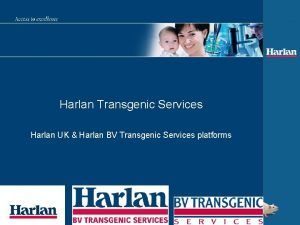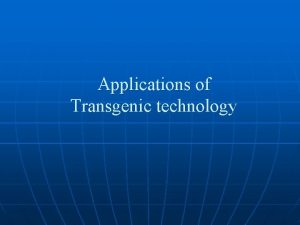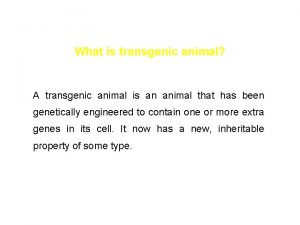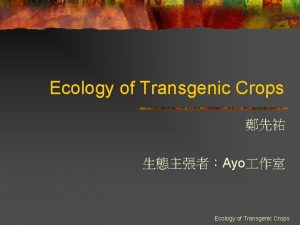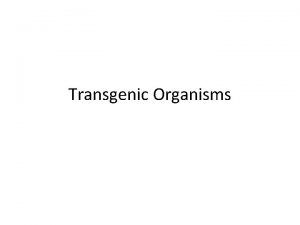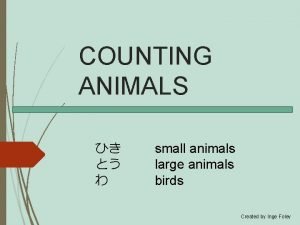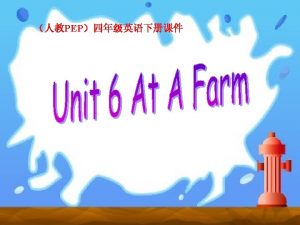Transgenic Animals Dr Azhar Chishti Department of Medical








































- Slides: 40

Transgenic Animals Dr. Azhar Chishti Department of Medical Biochemistry Dr. Azhar Chishti

LECTURE OUTLINES • Transgenic animals • Overview of transgenic mice • How to create transgenic animals • Transfer of DNA into eukaryotic cells • Confirming mutation in germ cells • Overview of knockout mice • How to make gene targeted knockout mice • Making ES cell containing knockout mutants • Forming chimeras • generating homozygous knockout mice • Use of transgenic & knockout mice to study human genetic diseases • Use of transgenics in gene therapy e. g. SCID Dr. Azhar Chishti

Transgenic Animals • • • Transgenic animals can be produced by injecting a cloned gene into the fertilized egg. A giant mouse called "Supermouse“ Transgenic goats and cows can produce human hormones in their milk. Sometimes, rather than introducing a functional gene into a transgenic mouse, a mutant gene is used to replace the normal copies of that gene in the cells of the mouse. This can be used to produce a colony of "knockout mice" that are deficient in a particular enzyme. Transgenic animals can serve as models for the study of a corresponding human disease. For example, transgenic mice of dystrophin gene serve as animal models for the study of muscular dystrophy. Dr. Azhar Chishti

Transgenic Animals 1. Transgenic mice 2. Knockin and knockout mice 3. Scid mice Dr. Azhar Chishti

Transgenic mice Developments in molecular biology and stem cell biology over the last 20 years have allowed researchers: To create custom-made mice through gene targeting in mouse embryonic stem (ES) cells. Site-directed mutagenesis in embryonic stem cells and the phenotypic characterization of the corresponding knockout and/or knockin mouse allows researchers to study gene function as it relates to the entire organism Now, certain diseases that normally do not present in mice, such as cystic fibrosis and Alzheimer's disease can be induced by manipulating the mouse genome and environment. Dr. Azhar Chishti

Transgenic mice Transgenesis is the introduction of DNA from one species into the genome of another species. �Transgenic mouse is generally refers to any mouse whose genome contains an inserted piece of DNA, originating from the mouse genome or from the genome of another species. �To study gene function in a mouse is exogenous expression of a protein in some or all tissues. Dr. Azhar Chishti

Transgenic mice (cont. ) The piece of DNA includes: a. the structural gene of interest b. a strong mouse gene promoter c. Enhancer to allow the gene to be expressed d. Vector DNA to enable the transgene to be inserted into the mouse genome. Dr. Azhar Chishti

Transgenic mice (cont. ) Successful insertion of DNA results in the expression of the transgene in addition to the wild type, basal (endogenous) protein levels in the mouse. Depending on the goal of the experiment, the transgenic mouse will exhibit over-expression: a. non-mutated protein, b. expression of a dominant-negative form of a protein, c. expression of a fluorescent-tagged protein. Dr. Azhar Chishti

Transgenic mice (cont. ) To generate a standard transgenic mice include bacterial or viral vector containing the transgene and any desired markers are injected into a fertilized mouse egg. The DNA usually integrates into one or more loci during the first few cell divisions of preimplantation development. The number of copies of the transgenic fragment can vary from one to several hundred and the transgenic founder mice are mosaic for the presence of the transgene. Founders are very likely to have germ cells with the integrated transgene, and therefore will be able to vertically transmit the integrated gene, and all cells of the progeny transgenic mouse contain the transgene. Dr. Azhar Chishti

Microinjection equipment Dr. Azhar Chishti

Transgenic mice (cont. ) This method is relatively quick, but includes the risk: a. DNA may insert itself into a critical locus, causing an unexpected, detrimental genetic mutation. b. Transgene may insert into a locus that is subject to gene silencing. c. If the protein being expressed from the transgene causes toxicity, excessive overexpression from multiple insertions can be lethal to some tissues or even to the entire mouse. several independent lines mice containing the same transgene must be created and studied to ensure that any resulting phenotype is not due to toxic gene-dosing or to the mutations created at the site of transgene insertion. Dr. Azhar Chishti

Why mice and why transgenics? Mice are a common “platform” shared with other biomedical researchers Mice can recapitulate key pathologies observed in human disease Trangenes allow access to all forms of a protein - better than toxicological phenocopy of disease. ENU no good - need humanized genes

The retina as a target for spontaneous prion formation Brain simple architecture photoreceptors replicate prions can transit between the retina and the CNS. prions formed in the retina can be amplified in the CNS, travel to the periphery.

Retinal photoreceptors as a target for de novo prion formation * Lens To brain Insult Optic nerve

e globin MAR lac. Z opsin promoter non-Tg Tg

Retinal transgenes e globin MAR lac. Z opsin promoter Pr. P E 200 K Pr. P F-CJD mutations E 200 K V 210 I Pr. P

Asymmetric photoreceptor cell degeneration in opsin/Pr. P mice Superior Hemisphere (SH) Inferior Hemisphere (IH)

ATG TAG APP 695 KM 670/671 NL V 717 F 42 kb Hamster Pr. P cosmid • Cosmid injected into C 57 B 6/C 3 H oocytes • Resultant line is denoted “Tg. CRND 8” • Maintained on C 57 B 6/C 3 H outbred or 129 Sv. Ev congenic


Protein expression from APP and PS 1 transgenes D 6 ND 8 6209 N g P -T CR CR AP n No Tg Tg Tg APP 98 Tg CRND 8 C 99 and Ab 60 120 180 240 300 Days b-stubs 6 Ab 4 k. Da Ab 6 E 10 64 APP 50 1 36 30 PS 1 16 12 k. Da APP CTF k. Da Ab 6 E 10 2 3 4 5 36 PS 1 NTF 30 k. Da Ab NT-1

Amyloid peptide in aging Tg. CRND 8 mice Age (weeks) n Ab 42 ng/g Ab 40 ng/g Ab 42/40 4 6 38 ± 3 54 ± 4 0. 7 ± 0. 02 6 7 54 ± 7 55 ± 7 1. 1 ± 0. 1 8 7 79 ± 30 56 ± 3 1. 5 ± 0. 5 10 5 409 ± 245 101 ± 76 5. 2 ± 1. 5 25 5 21780 ± 6600 10584 ± 1495 2. 0 ± 0. 6

Tg. CRND 8 Brain Pathology

Morris Water Maze Test Hidden platform “Swim path”

Latency (seconds) Learning acquisition in 11 week old Tg. CRND 8 mice Tg. CRND 8 Day 1 Day 2 Day 3 Session Day 4 Day 5

Ab Immunization Causes 50% Reduction Neuropathology What effect on ADa neuropathology? of Tg. CRND 8 Mice at Age of 25 Weeks IAPP vaccine Ab 42 vaccine

Ab-immunization prevents/stops memory deficit in the Tg. CRND 8 AD mouse Before Training Normal mouse AD mouse, IAPP ctl AD mouse, Aß 42 After Training AD mouse, Aß 42

Creating lab models of AD And the Oscar goes to… Tg. CRND 8

Knockin mice A knockin mouse is generated by targeted insertion of the transgene at a selected locus. Site-specific knockins result in a more consistent level of expression of the transgene from generation to generation because it is known that the overexpression cassette is present as a single copy. The targeted transgene is not interfering with a critical locus and the resulting phenotype is due to the exogenous expression of the protein. The generation of a knockin mouse does avoid many of the problems of a traditional transgenic mouse, this procedure requires more time to assemble the vector and to identify ES cells that have undergone homologous recombination. Dr. Azhar Chishti

Knockout mice Homologous recombination allows to completely remove one or more exons from a gene which results in the production of a mutated or truncated protein or, more often, no protein at all. knockout mice are generated to remove protein information by elimination of a gene or the deletion of a functional domain of the protein. This can be achieved through random mutation using chemical mutagenesis or a gene trap approach, or through gene targeting to generate a knockout mouse. Dr. Azhar Chishti

. Figure 1: Gene targeting for knockout mice Knockout mice Dr. Azhar Chishti

Conditional Knockout mice Many genes that participate in interesting genetic pathways are essential for either mouse development, viability or fertility. Therefore, a traditional knockout of the gene can never lead to the establishment of a knockout mouse strain for analysis. Conditional gene modification using Cre-lox technology allows the gene of interest to be knocked-out in only a subset of tissues or only at a particular time to avoid lethality. This genetic dissection allows researchers to define gene function in development, physiology or behavior. Dr. Azhar Chishti

. Figure 1: Gene targeting for knockout mice Conditional Knockout mice Dr. Azhar Chishti

Conditional Knockout mice Cre recombinase is isolated from the P 1 bacteriophage, catalyzes recombination between two of its consensus DNA recognition sites. These lox. P sites are 34 base pairs in length, consisting of two 13 bp palendromic sequences that flank a central sequence of 8 bp which determines the directionality of the lox. P site. Two lox. P sites are most often placed on either side of an essential, functional part of a gene so that recombination removes that functionality and knocks-out the gene. (See Figure 2) Lox. P sites placed on different chromosomes can be used to generate targeted translocations, though this recombination event occurs at a relatively low frequency compared to the highly-efficient intra-gene recombination Dr. Azhar Chishti

Presenilins Cytoplasm N C ER

Superimposed transgene None Tg. PS 1(M 146 L)1 Tg. PS 2(N 141 I)1032 Tg. PS 2(M 239 V)1379 Tg. APP 6209 PS 1 deficient mice

33 PS 1 d. genes 33 d. accelerate amyloid deposition in Tg. CRND 8 mice 33 d minus PS 1(M 146 L+L 286 V) 62 d PS 1(L 286 V)

A Transgenic Mouse Model of Human Alzheimer’s Disease HUMAN Amyloid deposition in HUMAN Alzheimer Disease Brain (70 years of age). MOUSE Amyloid deposition in AD transgenic MOUSE brain (92 days of age).

SCID mice These are immunodeficient mice Nude mice are T-cell deficient Scid mice are both T & B cell deficient They are use in Cancer studies They are use for gene therapy Dr. Azhar Chishti

References Lippincott, Illustrated review of Biochemistry, 4 th edition Transgenic and Knockout Mouse – Approaches (Website) http: //www. cellmigration. org/resource/komouse_approaches. s html Chishti MA et al. , . Early-onset amyloid deposition and cognitive deficits in transgenic mice expressing a double mutant form of amyloid precursor protein 695. 2001 Journal of Biological Chemistry. 276: 2156221570 Dr. Azhar Chishti

How to Improve your memory and intelligence? Follow the leaders!!!
 Discovery learning theory
Discovery learning theory Dr azhar hussain
Dr azhar hussain Pflng tiga
Pflng tiga Saiful azhar
Saiful azhar Azhar kasim
Azhar kasim Salman azhar
Salman azhar Saad azhar saeed ucp
Saad azhar saeed ucp Prof azhar kasim
Prof azhar kasim Compsci 111g
Compsci 111g Transgenic organism definition
Transgenic organism definition Transgenic organisms examples
Transgenic organisms examples Possible transgenic maize in oaxaca mexico
Possible transgenic maize in oaxaca mexico Transgenic bacteria
Transgenic bacteria Transgenic bacteria
Transgenic bacteria Transgenic
Transgenic Https://a-z-animals.com
Https://a-z-animals.com Are bears producers or consumers
Are bears producers or consumers Animals that eat both plants and animals
Animals that eat both plants and animals Animals that eat both plants and animals
Animals that eat both plants and animals Pros and cons of animal testing
Pros and cons of animal testing Medical records committee functions
Medical records committee functions Medical education and drugs department
Medical education and drugs department California medical license for foreign medical graduates
California medical license for foreign medical graduates Gbmc infoweb
Gbmc infoweb Difference between medical report and medical certificate
Difference between medical report and medical certificate Torrance memorial medical center medical records
Torrance memorial medical center medical records Cartersville medical center medical records
Cartersville medical center medical records Bougainvillea tropical rainforest
Bougainvillea tropical rainforest Deciduous forest plants adaptations
Deciduous forest plants adaptations The countess cathleen summary
The countess cathleen summary Non domesticated animals and uncultivated plant life
Non domesticated animals and uncultivated plant life Why did orwell use animals instead of people
Why did orwell use animals instead of people Chihuahuan desert animals
Chihuahuan desert animals Selective breeding animals
Selective breeding animals So many kinds of animals
So many kinds of animals Shaffer's formula
Shaffer's formula 5 vertebrate animals
5 vertebrate animals Dog cephalic vein
Dog cephalic vein Pebble go animals
Pebble go animals Example of hybridization in animals
Example of hybridization in animals Nutricio dels animals
Nutricio dels animals
